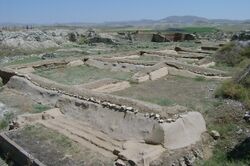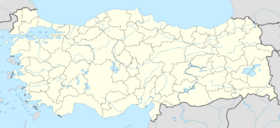Place:Gordium
Γόρδιον Gordiyon | |
 The ruins of Gordium | |
| Location | Yassıhüyük, Ankara Province, Turkey |
|---|---|
| Region | Phrygia |
| Coordinates | [ ⚑ ] : 39°39′18″N 31°59′39″E / 39.655°N 31.99417°E |
| Type | Settlement |
| History | |
| Builder | Thracian settlers |
| Founded | 12th century BCE |
Gordium (Greek: Γόρδιον, Górdion; Turkish: Gordion or Gordiyon) was the capital city of ancient Phrygia. It was located at the site of modern Yassıhüyük, about 70–80 km southwest of Ankara (capital of Turkey), in the immediate vicinity of Polatlı district. The site was excavated by Gustav Körte and Alfred Körte in 1900[1] and then by the University of Pennsylvania Museum of Archaeology and Anthropology, under the direction of Rodney S. Young, between 1950 and 1973.[2] Excavations have continued at the site under the auspices of the University of Pennsylvania Museum with an international team.
Gordium lies where the ancient road between Lydia and Assyria/Babylonia crossed the Sangarius river.
History
In the 12th century BCE, Gordium was settled by Brygians who had migrated from southeastern Europe. During the 9th and 8th centuries BCE, the city grew into the capital of a kingdom that controlled much of Asia Minor west of the river Halys. The kings of Phrygia built large tombs near Gordium called tumuli, which consist of artificial mounds constructed over burial chambers. There are about one hundred of them, covering both cremations and inhumations. In the 8th century, the lower city and the area to the north of the citadel was surrounded by a circuit wall with regularly spaced towers.
The most famous king of Phrygia was Midas. Contemporary Assyrian sources dating between c. 718 and 709 BCE call him Mit-ta-a. According to the Greek historian Herodotus, King Midas was the first foreigner to make an offering at the sanctuary of Apollo at Delphi, dedicating the throne from which he gave judgment.[3] During his reign, according to Strabo, the nomadic Cimmerians invaded Asia Minor, and in 710/709 BCE, Midas was forced to ask for help from the Assyrian king Sargon II. In Strabo's account, King Midas committed suicide by drinking bull's blood when the Cimmerians overran the city.[4]
Tumulus MM (for "Midas Mound"), the Great Tumulus, is the largest burial mound at Gordium, standing over 50 meters high today, with a diameter of about 300 meters. The tumulus was excavated in 1957 by Young's team, revealing the remains of the royal occupant, resting on purple and golden textiles in an open log coffin, surrounded by a vast array of magnificent objects. The burial goods included pottery and bronze vessels containing organic residues, bronze fibulae (ancient safety pins), leather belts with bronze attachments, and an extraordinary collection of carved and inlaid wooden furniture, exceptional for its state of preservation. The Tumulus MM funeral ceremony has been reconstructed, and scientists have determined that the guests at the banquet ate lamb or goat stew and drank a mixed fermented beverage.[5][6] It is now generally assumed to be the tomb of Midas' father Gordias, and was probably the first monumental project of Midas after his accession.
Date of the destruction
There is ample evidence of widespread burning of the city mound of Gordium, in a level referred to by Young as the destruction level. Archaeologists at first interpreted the destruction level as the remains of a Cimmerian attack, c. 700 BCE. The traces were later reinterpreted as dating to c. 800 BCE, largely on the basis of dendrochronology and radiocarbon analysis, and with reference to the types of objects found in the burned level.[7] If this reinterpretation is correct, then the otherwise-unrecorded destruction would seem to have been caused by a conflagration unrelated to a Cimmerian attack. The earlier date, though, is contested, primarily on the basis of the types and styles of objects excavated in the destruction level, the latest of which are dated to c. 700 BCE by some scholars.[8][9] The radiocarbon date seems to have a range wide enough to accommodate both proposed archaeological dates.[10] Although the date of the destruction continues to be debated, a date of c. 800 BCE is now most-commonly accepted.[11]
Gordian Knot
According to ancient tradition, in 333 BCE Alexander the Great cut (or otherwise unfastened) the Gordian Knot: this intricate knot joined the yoke to the pole of a Phrygian wagon that stood on the acropolis of the city. The wagon was associated with Midas or Gordias (or both), and was connected with the dynasty's rise to power. A local prophecy had decreed that whoever could loosen the knot was destined to become the ruler of Asia.[12]
Notes
- ↑ G. and A. Körte, Gordion: Ergebnisse der Ausgrabung im Jahre 1900. Jahrbuch des kaiserlich deutschen archäologischen Instituts V (Berlin, 1904).
- ↑ R.S. Young, Three Great Early Tumuli. The Gordion Excavations Final Reports, Volume 1 (Philadelphia, 1981).
- ↑ Histories (Herodotus) 1.14.
- ↑ Strabo 1.3.21. L. Roller, "The Legend of Midas", Classical Antiquity 2(1983): 299–313.
- ↑ E. Simpson, “Midas’ Bed and a Royal Phrygian Funeral”, Journal of Field Archaeology, 17(1990): 69–87.
- ↑ P. McGovern, D. Glusker, R. Moreau, A. Nuñez, C. Beck, E. Simpson, E. Butrym, L. Exner, and E. Stout, “A Funerary Feast Fit for King Midas”, Nature 402(1999): 863–864.
- ↑ K. DeVries et al., "New dates for the destruction levels at Gordion", Antiquity 77 (June 2003)
- ↑ O.W. Muscarella, "The date of the destruction of the Early Phrygian Period at Gordion", Ancient West & East 2, 225–252 (2003). (Argues against the earlier date.)
- ↑ M.M. Voigt, "Old Problems and New Solutions: Recent Excavations at Gordion," in: L. Kealhofer (Ed.) The Archaeology of Midas and the Phrygians (Philadelphia, 2005), 28–31. (Argues for the reinterpretation of the archaeological evidence.)
- ↑ D.J. Keenan, "Radiocarbon dates from Iron Age Gordion are confounded", Ancient West & East 3, 100–103 (2004).
- ↑ C. B. Rose, G. Darbyshire [Editors], The New Chronology of Iron Age Gordion (Philadelphia: University of Pennsylvania Museum, 2011).
- ↑ L. Roller, "Midas and the Gordian Knot." Classical Antiquity 3(1984): 256–271.
Further reading
- Keith DeVries (editor). From Athens to Gordion (Philadelphia: University Museum, 1980).
- Peter Grave, Lisa Kealhofer, Ben Marsh, G. Kenneth Sams, Mary Voigt, Keith DeVries (2009), "Ceramic production and provenience at Gordion, Central Anatolia", Journal of Archaeological Science, 36, 2162-2176.
- Ann C. Gunter. Gordion Excavations Final Reports Vol. III: The Bronze Age (Philadelphia: University Museum, 1991).
- Ellen L. Kohler. The Gordion Excavations (1950–1973) Final Reports, Vol. II: The Lesser Phrygian Tumuli, Part 1, The Inhumations (Philadelphia, 1995).
- Gustav Körte and Alfred Körte. "Gordion: Ergebnisse der Ausgrabung im Jahre 1900". Jährliches Ergänzungsheft 5 (Berlin, 1904). (In German.)
- Frank Matero and Meredith Keller, eds. Gordion Awakened: Conserving A Phrygian Landscape (Philadelphia: Architectural Conservation Laboratory, 2011).
- Machteld Mellink. A Hittite Cemetery at Gordion (Philadelphia: University Museum, 1956).
- Naomi F. Miller. 2010, Botanical Aspects of Environment and Economy at Gordion, Turkey, Gordion Special Studies V. Philadelphia: University of Pennsylvania Museum.
- Oscar White Muscarella. Phrygian Fibulae from Gordion. (London: Colt Archaeological Institute, 1967).
- Lynn Roller. Gordion Special Studies, Vol. I: Nonverbal Graffiti, Dipinti, and Stamps (Philadelphia: University Museum, 1987).
- Irene Romano. Gordion Special Studies Vol. II: The Terracotta Figurines and Related Vessels (Philadelphia: University Museum, 1995).
- C. Brian Rose (Ed.). 2012, The Archaeology of Phrygian Gordion, Royal City of Midas. Proceedings of a conference held at the Penn Museum. Philadelphia: University of Pennsylvania Museum.
- G. Kenneth Sams. The Gordion Excavations, 1950–1973: Final Reports, Vol. IV: The Early Phrygian Pottery (Philadelphia: University Museum, 1994).
- Elizabeth Simpson. The Gordion Wooden Objects, Vol. 1: The Furniture from Tumulus MM (Leiden and Boston: Brill, 2010).
- Elizabeth Simpson and Krysia Spirydowicz. Gordion Wooden Furniture: The Study, Conservation, and Reconstruction of the Furniture and Wooden Objects from Gordion, 1981–1998 (Ankara: Museum of Anatolian Civilizations, 1999).
- Rodney Young et al. Gordion Excavations Reports, Vol. I: Three Great Early Tumuli [P, MM, W] (Philadelphia: University Museum, 1981).
External links
| Library resources about Gordium |
- The Gordion Archaeological Project official site
- Conservation at Gordion by the University of Pennsylvania's Architectural Conservation Laboratory
- Excavation, Study of Material Excavated 1988–1996, Regional Surface Survey, and Ethnographic Survey by Mary Voigt.
- Erosion, Biodiversity, and Archaeology: Preserving the Midas Tumulus at Gordion by Naomi F. Miller
- Livius.org: Phrygians
- University of Pennsylvania Museum excavations at Gordion
- Pictures from the museum, Midas tumulus and actual Gordium



